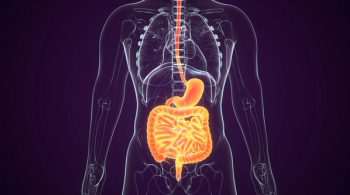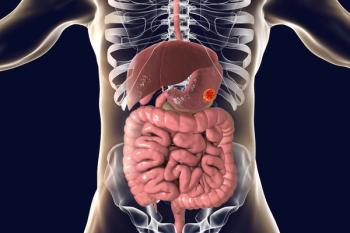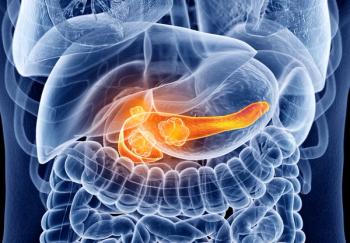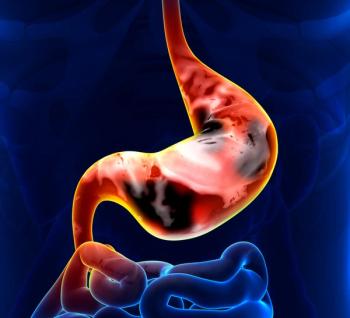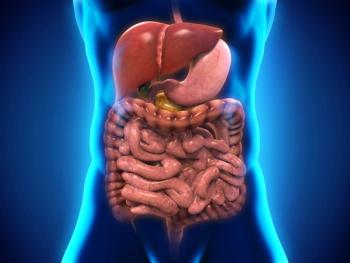
Oncology NEWS International
- Oncology NEWS International Vol 9 No 7
- Volume 9
- Issue 7
Trend Toward Improved Outcomes With 5-FU/LV Plus RhuMabVEGF in Colorectal Cancer
SAN FRANCISCO-RhuMAb VEGF (recombinant humanized monoclonal antibody to vascular endothelial cell growth factor) in combination with 5-fluorouracil/leucovorin chemotherapy (5-FU/LV) is well tolerated and may increase response rates and prolong time to disease progression in previously untreated metastatic colorectal cancer, as compared with 5-FU/LV alone.
SAN FRANCISCORhuMAb VEGF (recombinant humanized monoclonal antibody to vascular endothelial cell growth factor) in combination with 5-fluorouracil/leucovorin chemotherapy (5-FU/LV) is well tolerated and may increase response rates and prolong time to disease progression in previously untreated metastatic colorectal cancer, as compared with 5-FU/LV alone.
The finding comes from a study among 104 patients who were either chemotherapy-naive or who had received adjuvant therapy at least 12 months before enrollment. Study results were presented at the ASCO meeting by Emily Bergsland, MD, University of California, San Francisco.
VEGF, a potent regulator of angiogenesis, is overexpressed in many human cancers, Dr. Bergsland noted. In the case of colon cancer, she said, high levels of VEGF expression frequently portend a poor prognosis.
Response Rates Increased
Patients with prior therapy for metastatic disease were excluded from the study, although adjuvant therapy at least 1 year prior was allowed. Patients at 35 separate sites were randomized to one of three arms: 5-FU/LV alone or in combination with low-dose (5 mg/kg) or high-dose (10 mg/kg) rhuMAb VEFG. Patients were treated until disease progression or the end of the 1-year treatment period.
5-FU/LV was administered via the Roswell Park regimen consisting of weekly infusions for 6 weeks followed by a 2-week rest. Those receiving rhuMAb VEGF were given an intravenous injection every 2 weeks continuously. Tumor assessments were conducted at the end of every 8-week cycle.
Response rates in the rhuMAb VEGF arms were increased to a statistically significant level (P = .03) in the lower-dose arm. The response rates were 40% for the low-dose arm and 24% for the high-dose arm, compared with 17% for the control group.
Time to progression was increased significantly again in the 5-mg arm to 9 months (P = .005). For the high-dose group, time to progression was 7.2 months, compared with 5.2 months for the control group.
Preliminary survival analysis also favored the 5-mg dose. Survival was 13.8 months for the control group, 17.3 (median not yet reached) for the 5-mg group, and 16.1 months for the 10-mg group.
This analysis, Dr. Bergsland underscored, may be confounded by the crossover of 22 of 36 control patients to rhuMAb VEGF after disease progression. Ten of 22 rhuMAb VEGF patients received treatment for more than 4 months, and 2 had partial responses lasting 3 and 5 months.
At Least One Adverse Event
Dr. Bergsland reported that while therapy was generally well tolerated, all participants experienced at least one adverse event, and those in the rhu-MAb VEGF arms experienced more grade 3-4 events (74% at 5 mg; 72% at 10 mg). She commented, however, that those patients were in treatment longer, which may have accounted for the higher event incidence.
Diarrhea was the most common side effect. Typical chemotherapy toxicity rates (leukopenia, stomatitis, diarrhea) were not increased.
The rhuMAb VEGF arms also experienced increases in GI bleeding, epistaxis, and hypertension.
A trend toward increased thrombotic events (9% with 5-FU/LV alone, 26% with 5 mg rhuMAb, 13% with 10 mg rhuMAb) included phlebitis at the site of chemotherapy infusion, deep-vein thrombosis, and femoral artery embolism. While in all but four cases treatment was continued, there was one fatality attributed to pulmonary embolism in the 10-mg/kg arm.
Dr. Bergsland concluded that rhuMAb VEGF at 5 mg/kg plus 5-FU/LV resulted in statistically significant increases in response rates and time to progression compared with chemo alone. The relationship between dose and efficacy, she noted, remains unclear.
Taken together, these data suggest that rhuMAb VEGF may have activity in colon cancer and warrants additional study, Dr. Bergsland said.
Articles in this issue
over 25 years ago
Couric Urges Doctors to Talk to Patients About Colon Cancerover 25 years ago
Automated Imaging Notification System Close to Fail-Safeover 25 years ago
Higher Dairy Consumption Linked to Prostate Cancer Riskover 25 years ago
First-Year Funding of Early Detection Research Network Completeover 25 years ago
Gritty Antitobacco Ads and More From Legacy Foundationover 25 years ago
Tositumomab Effective for Low-Grade Follicular Lymphomaover 25 years ago
New Awards Spotlight Courage of Cancer Survivorsover 25 years ago
Hospital Volume Shown to Predict Breast Cancer Outcomeover 25 years ago
New Drug Information Websiteover 25 years ago
NCCN Presents Updated Colorectal Cancer GuidelinesNewsletter
Stay up to date on recent advances in the multidisciplinary approach to cancer.


